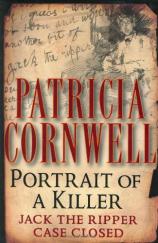Portrait of a Killer: Jack the Ripper -- Case Closed
Review
Portrait of a Killer: Jack the Ripper -- Case Closed
For more than a century, the mystery of "who was Jack the Ripper" has fascinated both sides of the Atlantic. Who perpetrated the brutal murders of so many Whitechapel prostitutes in England in the late 1800s? And why?
Numerous theories have been put forth over the decades: a lunatic, a crazed doctor, a member of the royal family, a famous artist. And now, for the first time, someone has taken Scotland Yard's evidence, along with other letters and ephemera, and applied modern-day forensic science to the still-open investigation.
The someone is Patricia Cornwell, author of the critically acclaimed Kay Scarpetta mystery series and a forensic specialist herself. The results, while not entirely convincing, are compelling.
Cornwell asserts, with great confidence, that Jack the Ripper was the impressionist artist Walter Richard Sickert, an apprentice to Whistler, and, in his own right, a highly accomplished and recognized artist. In fact, Cornwell posits that Sickert's work is perhaps one of the greatest clues of his culpability. First, his paintings are menacing and threatening, particularly towards women of a lower class. Also, known as an artist who painted what he saw, a few of Sickert's canvasses eerily resemble the Ripper's crime scenes. Coincidence? Perhaps. But Cornwell interprets his work as revelatory, confessional almost. In profiling the famous serial killer she suggests that the Ripper would have been a man who harbored a keen, deep-rooted hatred of women, most likely founded in his own sexual inability or inadequacies. Sickert at a young age underwent a series of corrective penile surgeries, which quite possibly left him impotent. There is no proof one way or another that he was entirely sexually dysfunctional, but there are hints at problems that lend some credence to Cornwell's theory.
The Ripper did not exist in a vacuum, and Cornwell did an extraordinary job of setting the scene, placing the reader in late 1800 England. Detailed references to John Merrick (the elephant man), Henry Irving (one of the stage's greatest stars of the time), Henry James (author and constable) and others frame Cornwell's story. The Ripper was very much a part of the happenings of the time, and his name was as likely to be found in the pages of the newspaper as any of the abovementioned notables. Sickert, a voracious reader with morbid sensibilities would have been captivated by the stories of the Ripper. As a prankster and prolific writer, he might even have been tempted to pen a faux Ripper letter or two to the police or the daily paper. (At the time, many of the Ripper letters were thought to be hoaxes.) As a murderer, if he was a murderer, Sickert's well-known vanity would have thrilled at and thrived on the publicity. To be mentioned on the same pages as royalty and celebrities would have fed his hungry ego.
Cornwell offered much supposition and hints at Sickert's guilt. For instance, he was a master of disguise and could have easily lured a prostitute to her death and then escaped undetected, Cornwell suggests. He was enthralled by the music halls and the "unfortunates" who frequented them, and he was known to walk the streets of the Whitechapel area late at night for long periods of time. He had an unhealthy fascination of the anatomy of the human body that went far beyond an artist's natural curiosity. And the Ripper letters included allusions Sickert would have known and drawings in the fashion of Sickert's own work.
From DNA to mitochondrial DNA, from handwriting experts to watermark experts, from newspaper articles to authentic Sickert paintings, Cornwell left no stone unturned. She described in lay terms --- using easily understood analogies --- the forensic methodologies she and her impressive crew of colleagues used in their thorough investigation. Along the way she spent an exorbitant amount of money trying to prove his guilt. (She even went so far as to purchase several of his paintings, and destroyed one in the hopes of finding conclusive evidence.) The science is fascinating, albeit more often inconclusive than convincing. Her research did not always glean the results she had hoped for. But taken all together, the evidence, mostly circumstantial, is damning and probably would have been enough in today's court system to bring Sickert to trial.
Case Closed? I can't say I was convinced by book's end that Sickert was indeed the Ripper. I wanted a smoking gun that left no room for doubt, and Cornwell did not deliver a smoking gun because she did not find one. She found compelling evidence that makes the strongest case of guilt to date. But with no death bed confession, or bloodstained canvasses, or eyewitness reports, we will never really know his innocence or guilt. The strong science, the history lesson, and the story of Sickert's life make PORTRAIT OF A KILLER an intriguing read, and on those fronts I recommend the book. But I leave you to decide for yourself if she has found enough evidence to label Sickert the Ripper --- or not.
Reviewed by Roberta O'Hara on January 22, 2011
Portrait of a Killer: Jack the Ripper -- Case Closed
- Publication Date: November 11, 2002
- Genres: Nonfiction
- Hardcover: 400 pages
- Publisher: Putnam Adult
- ISBN-10: 0399149325
- ISBN-13: 9780399149320





